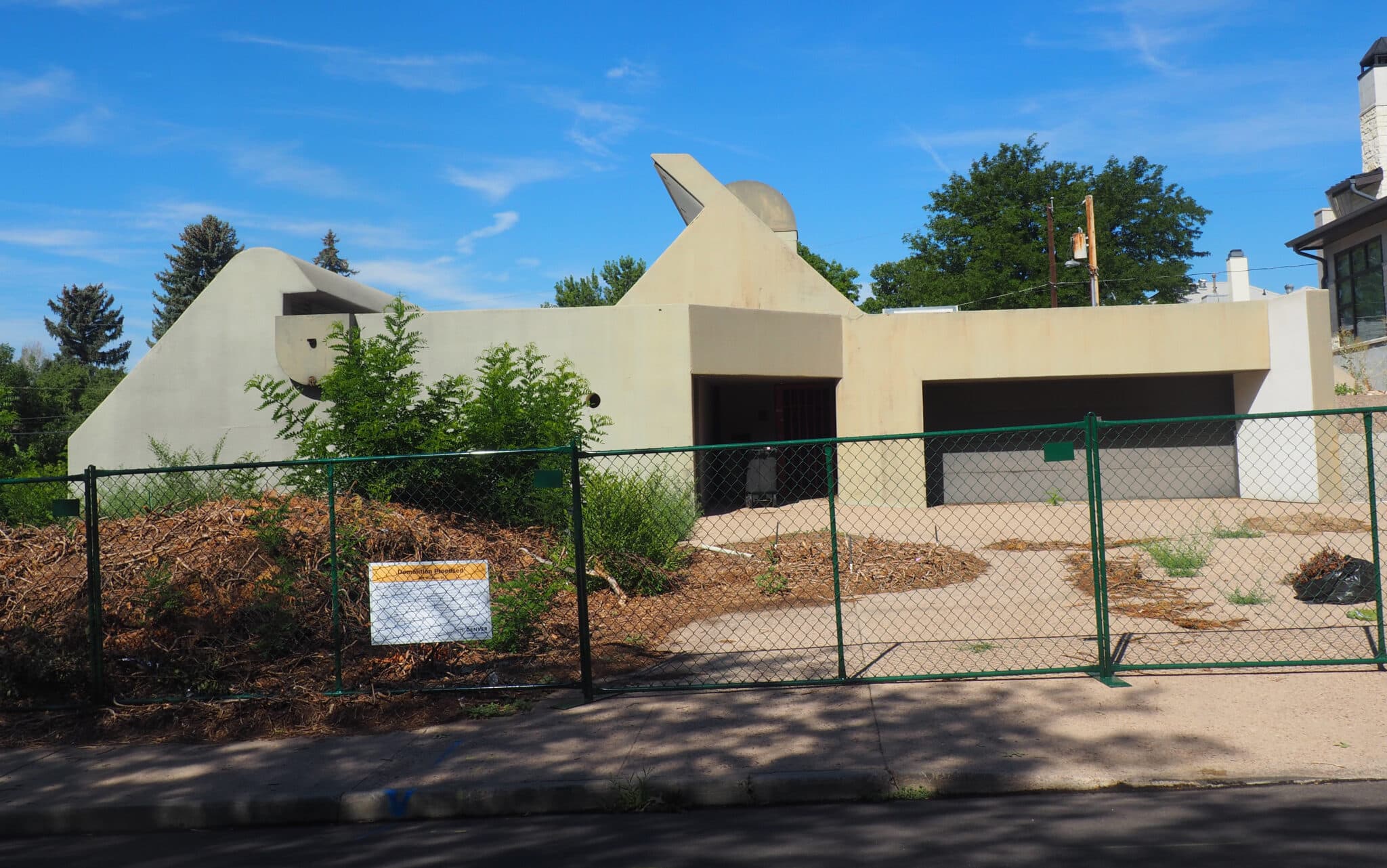
The new owner of the home at 401 N. Madison St. in Cherry Creek is a homebuilder that wants to demolish the home and construct two duplexes on the lot. (BusinessDen file photo)
An owner-opposed landmark designation application that would save a late architect’s Cherry Creek home from the wrecking ball will be voted on by the Denver City Council next month.
A council committee voted Tuesday to forward the application for 401 N. Madison St., a home completed in 1979 that was designed by and built for Richard Crowther.
The vote was largely procedural, and doesn’t necessarily mean that the committee members will support the application in the final vote. That vote is scheduled for the Dec. 12 meeting, and will come after the public is given a chance to speak.

Richard Crowther was known for his energy-conserving architecture. (Photo courtesy of Denver Public Library/Rocky Mountain News)
Crowther, who died in 2006, designed elements at Lakeside Amusement Park and buildings for King Soopers and Cooper Cinerama movie theaters, among other things. His home represents an early attempt at energy-saving architecture.
The landmark application is opposed by MAG Builders, a Denver-based homebuilder that purchased the home on 0.29 acres in May for $4 million. MAG wants to demolish the structure, build a pair of duplexes and sell each unit for $2 million or more.
MAG applied to the city over the summer for a demolition permit for the structure, which prompted three Denver residents — Tom Hart, Alan Gass and Michael Hughes — to file the landmark application. Designating the structure a city landmark would effectively prevent demolition.
The application has received relatively little public support. As of Nov. 10, the city had received 21 letters, a 33-signature petition and one voicemail opposing landmark status. Five letters of support had been submitted. Additionally, the majority of those who spoke at a Nov. 1 meeting of the city’s Landmark Preservation Commission opposed the measure.
The council’s Land Use, Transportation and Infrastructure Committee spent less than half an hour discussing the application at the Tuesday meeting, and asked questions of both MAG executives and the applicants.
MAG CFO Michael Moylen began his remarks by distributing a report detailing a recent structural inspection of the building. Moylen previously told BusinessDen it could take up to $1.2 million to renovate the structure, but on Tuesday revised that estimate upward.
“After we got this report and then our home inspection report, we think this would be a renovation around $2.8 million to $3 million dollars,” he told the committee.
Councilwoman Amanda Sawyer questioned a city staff member regarding the city’s conclusion that the home had “integrity,” given the concerns about the building’s condition.
“There are kids skateboarding on the roof,” Sawyer said. “It is not in good condition.”
Principal City Planner Kara Hahn responded that the city doesn’t assess condition but rather historic integrity, which basically means the building still looks like it did in the past.
Sawyer also asked about the mediation process, during which MAG offered to sell the home to someone who would preserve it as long as the company didn’t lose money on the deal.
“They could not find anyone to take on something of this cost,” Moylen said of the applicants, who were supported in part by the nonprofit Historic Denver.
Councilwoman Kendra Black asked what has happened to the home since the deaths of Crowther and his wife, who passed a year after he did. MAG is the fourth owner of the home since the Crowthers, and Moylen said it has been vacant that entire time.
“When you walk through, you can tell that’s the case,” Moylen said.
Moylen said he didn’t know what the previous owners’ intentions for the property were when they bought it. He said MAG is familiar with the Cherry Creek neighborhood, and has sold other units in nearby duplexes it constructed for $2 million.
As for the look of what would be built at 401 Madison, “we have not designed it yet because of the standstill,” Moylen said.
Councilman Chris Herndon asked how close the three applicants live to the home. Gass lives in Cherry Creek while Hughes and Hart live across Colorado Boulevard in Hilltop.
Hughes actually lives in another home designed by Richard Crowther. Hughes said the structure was in poor condition before he bought and renovated it.
That prompted a question from Sawyer.
“Why not landmark your house?” the councilwoman asked.
“Because it’s not at risk,” Hughes responded.
“Well, right,” Sawyer said. “But the purpose of landmarking something is not just to protect something, right? It is because it is a historic structure that should exist in our city for the future. So why not landmark your house?”
“I think we’re probably going to do what Alan (Gass) is doing — landmarking his own house,” Hughes said. “So at some point it will make sense for us to do it. Again, it’s not necessary today because it’s not at risk of being demolished. We just haven’t done it yet.”

The new owner of the home at 401 N. Madison St. in Cherry Creek is a homebuilder that wants to demolish the home and construct two duplexes on the lot. (BusinessDen file photo)
An owner-opposed landmark designation application that would save a late architect’s Cherry Creek home from the wrecking ball will be voted on by the Denver City Council next month.
A council committee voted Tuesday to forward the application for 401 N. Madison St., a home completed in 1979 that was designed by and built for Richard Crowther.
The vote was largely procedural, and doesn’t necessarily mean that the committee members will support the application in the final vote. That vote is scheduled for the Dec. 12 meeting, and will come after the public is given a chance to speak.

Richard Crowther was known for his energy-conserving architecture. (Photo courtesy of Denver Public Library/Rocky Mountain News)
Crowther, who died in 2006, designed elements at Lakeside Amusement Park and buildings for King Soopers and Cooper Cinerama movie theaters, among other things. His home represents an early attempt at energy-saving architecture.
The landmark application is opposed by MAG Builders, a Denver-based homebuilder that purchased the home on 0.29 acres in May for $4 million. MAG wants to demolish the structure, build a pair of duplexes and sell each unit for $2 million or more.
MAG applied to the city over the summer for a demolition permit for the structure, which prompted three Denver residents — Tom Hart, Alan Gass and Michael Hughes — to file the landmark application. Designating the structure a city landmark would effectively prevent demolition.
The application has received relatively little public support. As of Nov. 10, the city had received 21 letters, a 33-signature petition and one voicemail opposing landmark status. Five letters of support had been submitted. Additionally, the majority of those who spoke at a Nov. 1 meeting of the city’s Landmark Preservation Commission opposed the measure.
The council’s Land Use, Transportation and Infrastructure Committee spent less than half an hour discussing the application at the Tuesday meeting, and asked questions of both MAG executives and the applicants.
MAG CFO Michael Moylen began his remarks by distributing a report detailing a recent structural inspection of the building. Moylen previously told BusinessDen it could take up to $1.2 million to renovate the structure, but on Tuesday revised that estimate upward.
“After we got this report and then our home inspection report, we think this would be a renovation around $2.8 million to $3 million dollars,” he told the committee.
Councilwoman Amanda Sawyer questioned a city staff member regarding the city’s conclusion that the home had “integrity,” given the concerns about the building’s condition.
“There are kids skateboarding on the roof,” Sawyer said. “It is not in good condition.”
Principal City Planner Kara Hahn responded that the city doesn’t assess condition but rather historic integrity, which basically means the building still looks like it did in the past.
Sawyer also asked about the mediation process, during which MAG offered to sell the home to someone who would preserve it as long as the company didn’t lose money on the deal.
“They could not find anyone to take on something of this cost,” Moylen said of the applicants, who were supported in part by the nonprofit Historic Denver.
Councilwoman Kendra Black asked what has happened to the home since the deaths of Crowther and his wife, who passed a year after he did. MAG is the fourth owner of the home since the Crowthers, and Moylen said it has been vacant that entire time.
“When you walk through, you can tell that’s the case,” Moylen said.
Moylen said he didn’t know what the previous owners’ intentions for the property were when they bought it. He said MAG is familiar with the Cherry Creek neighborhood, and has sold other units in nearby duplexes it constructed for $2 million.
As for the look of what would be built at 401 Madison, “we have not designed it yet because of the standstill,” Moylen said.
Councilman Chris Herndon asked how close the three applicants live to the home. Gass lives in Cherry Creek while Hughes and Hart live across Colorado Boulevard in Hilltop.
Hughes actually lives in another home designed by Richard Crowther. Hughes said the structure was in poor condition before he bought and renovated it.
That prompted a question from Sawyer.
“Why not landmark your house?” the councilwoman asked.
“Because it’s not at risk,” Hughes responded.
“Well, right,” Sawyer said. “But the purpose of landmarking something is not just to protect something, right? It is because it is a historic structure that should exist in our city for the future. So why not landmark your house?”
“I think we’re probably going to do what Alan (Gass) is doing — landmarking his own house,” Hughes said. “So at some point it will make sense for us to do it. Again, it’s not necessary today because it’s not at risk of being demolished. We just haven’t done it yet.”
